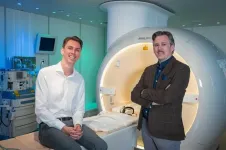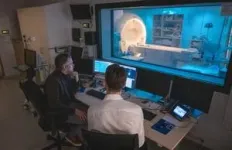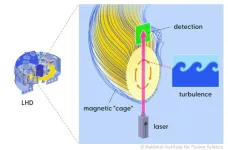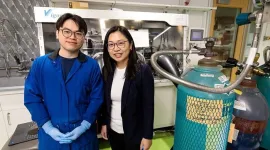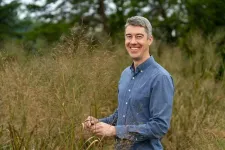(Press-News.org) Abnormal blood flow in the aorta is linked to inflammation and breakdown of the vessel wall in conditions where the aorta is dilated. This is shown in a study led by researchers at Linköping University. The findings can contribute to better diagnosis and open up new ways to assess the risk of serious and usually fatal complications, such as rupture of the aorta.
All blood in the body passes through the heart about once a minute. With every heartbeat, blood from the heart is pumped up into the aorta.
Dilation can occur in all parts of the aorta. It is unclear exactly how this happens, but one explanation may be weakening of the connective tissue in the vessel wall. Factors such as elevated blood pressure, age and various hereditary conditions increase the risk. A person affected by aortic dilation usually does not notice anything. But more and more people with aortic dilation are being discovered by healthcare – often by chance.
“In healthcare, we’re doing more and more imaging where we look at, for example, the heart or lungs, and then we can find that the patient’s aorta is a little larger than normal in some parts. There’s a need for more tools to guide doctors on how to handle these patients. In a minority of them, the aorta will unfortunately dilate more, and, in the worst case, the aorta will rupture, which is usually fatal,” says Filip Hammaréus, PhD student at the Department of Health, Medicine and Caring Sciences at Linköping University and intern physician at Ryhov County Hospital in Jönköping.
Most people with aortic dilation are offered regular surveillance of the aortic diameter – the larger the diameter, the higher the risk. Sometimes the aorta is operated on preventively to avoid acute complications, but it can rupture before dilation has become so pronounced that surgery is considered appropriate. At the same time, many examinations are made of people whose aortic diameter does not change. New methods for early identification of patients at elevated risk of growth could contribute to more individualised and cost-effective care. Therefore, the researchers behind the current study, published in the journal European Heart Journal – Cardiovascular Imaging, are investigating new methods for understanding both the risk and the condition itself.
“We can be onto something new, which can say something more about the severity of the disease than what the aortic diameter shows,” says Petter Dyverfeldt, professor at Linköping University and affiliated to the Center for Medical Image Science and Visualization, who has led the study.
When blood is pushed out of the heart into the aorta, a frictional force occurs between the flowing blood and the vessel wall. This is important for a type of cell that is located in the vessel wall and can sense blood flow. When the frictional force is normal, the cells tend to be healthy. However, if the friction significantly changes direction, or becomes very low or abnormal in other ways, there seems to be a signalling into the vessel wall that can eventually lead to a weakening.
Blood flow through the body’s large vessels and in the heart can be measured and visualised with magnetic resonance imaging, using an advanced technology called 4D flow MRI that is available in a small number of hospitals. This gives the researchers a picture of how blood flow affects the vessel wall.
In the current study, the researchers have carried out such measurements and also measured various proteins in the blood. It turned out that there existed interesting relationships between the effect of blood flow on the aortic wall and various proteins that relate to inflammation and the build-up and degradation of connective tissue.
“We see that in patients with dilated aorta, abnormal blood flow dynamics are associated with increased inflammation and turnover of connective tissue – something we believe can reflect processes in the vessel wall. This seems reasonable based on the mechanisms that have been shown in previous research, but it’s completely new to show the connections in the way we do now using a combination of magnetic resonance imaging and blood samples,” says Filip Hammaréus.
The findings strengthen previous research, but also bring new insights.
“What’s interesting about the findings in our study is that the measures of how blood flow affects the aortic wall were not linked to the diameter of the aorta. So, the traditional measure that’s often used in healthcare was not part of the relationship we see in the study between abnormal blood flow, inflammation and breakdown of the vessel wall,” says Petter Dyverfeldt.
The study was conducted on 47 men and women who participated in the Swedish CArdioPulmonary bioImage study (SCAPIS) and whose aortic diameter was over 40 mm. They were compared with 50 control subjects who were matched by sex and age.
The research has been funded with support from, among others, ALF Grants, Region Östergötland, Linköping University, Region Jönköping (Futurum) and the Swedish Research Council. The main funder of SCAPIS is the Swedish Heart-Lung Foundation.
Article: Wall shear stress measured with 4D flow CMR correlates with biomarkers of inflammation and collagen synthesis in mild-to-moderate ascending aortic dilation and tricuspid aortic valves, Filip Hammaréus, Chiara Trenti, Hanna M Björck et al, (2024). European Heart Journal – Cardiovascular Imaging, published online15 May 2024, doi: 10.1093/ehjci/jeae130
The SCAPIS study
SCAPIS (Swedish CArdioPulmonary bioImage Study) is a Swedish population study that recruits and examines the heart and lung status of 30,000 randomly invited women and men aged 50 to 64. The purpose is to identify individuals’ risk of heart diseases and to prevent them before they arise. The study is a collaboration between six university hospitals in Sweden, with the Heart-Lung Foundation as main financer.
Facts:
The aorta is shaped like a walking stick with a curved handle. From the heart, the aorta goes up into a bend (the “handle”) and from there the long part of the vessel passes down through the chest to the abdomen.
It is easier to find dilated aortas, or aneurysms, on the part of the aorta located in the abdomen. In Sweden, all men over the age of 65 are offered screening for abdominal aortic aneurysm. In the current study, the researchers focused on the dilation of another part of the aorta – the very first part after the heart – that is difficult to find with ultrasound and is not included in the screening programme. END
Disturbed blood flow can damage the vessel wall in cases of aortic dilation
2024-06-10
ELSE PRESS RELEASES FROM THIS DATE:
Psychosocial skills can stop relapse in people with eating disorders, says expert
2024-06-10
Health services should teach patients with eating disorders psychosocial skills to help more people recover and avoid relapse, according to an expert.
Anorexia, bulimia and other eating issues affect millions of people, and eating disorder specialist Bethany Crowley warns that eating disorders are often misunderstood. She suggests a more integrated approach to treating people is needed, to focus on the whole person rather than just the disordered eating.
Quieting negative thoughts, learning to cope with emotional triggers and practicing self-compassion are among nine key skills outlined by the therapist in a new book.
An Integrative Approach to Treating Eating ...
The discovery of new turbulence transition in fusion plasmas
2024-06-10
Background
Fusion energy is that released when two light nuclei combine to form a single heavier one (nuclear fusion reaction). Fusion energy-based power generation (fusion power plant) uses the energy generated when deuterium and tritium combine to form helium. A nuclear fusion reaction does not produce carbon dioxide. In addition, since it is possible to extract deuterium and tritium from the sea water, fusion energy is regarded as a sustainable energy source, and research into its practical application has been progressing rapidly ...
Glowing dye helps surgeons eradicate prostate cancer
2024-06-10
A glowing marker dye that sticks to prostate cancer cells could help surgeons to remove them in real-time, according to a study funded by Cancer Research UK.
Cancer Research UK-funded scientists, based at the Nuffield Department of Surgical Sciences and the Department of Oncology, University of Oxford, Oxford University Hospitals and Oxford NIHR Biomedical Research Centre used a fluorescent dye attached to a special marker molecule to give medics a “second pair of eyes” during surgery for prostate cancer.
Twenty-three men with prostate cancer were injected with the marker dye before undergoing prostate removal surgery. The marker dye found areas of cancerous tissue ...
Study: ALS patients treated by neurologists received better care
2024-06-08
ALS patients received better care if they were treated by a neurologist, a new study published in PLOS One has found.
But researchers found that Black, older and socially disadvantaged ALS patients were less likely to see a neurologist, raising concerns about equity in treating the deadly disease.
Patients who were treated by neurologists were more likely to receive interventions endorsed by the American Academy of Neurology.
“This study highlights the importance of neurologist care for ALS patients and the need to overcome barriers and provide care that is more equitable for ALS patients,” ...
What makes roads safer? New UMD study uses AI to find out
2024-06-07
College Park, Md. – Most people use Google Street View to find their way. Dr. Quynh Nguyen, an epidemiologist and statistician at the University of Maryland School of Public Health, uses it to locate spots where your journey might abruptly end. In a study published June 6 in the British Medical Journal (BMJ) of Injury Prevention, Nguyen identifies uses AI tools to identify key environmental elements impacting car-related collisions as well as cyclist-related and pedestrian-related accidents.
“Car crashes are the leading cause of death for young people ...
Accessibility issues in cancer care
2024-06-07
Researchers at the University of Michigan are finding that many patients may be encountering significant barriers to cancer care, even from their first phone call to a clinic.
Patients attempting to access cancer care must go through several different levels of communication, both before their initial appointment with a physician and throughout their treatment.
Making those first calls to learn more about available cancer care services or to schedule an appointment at a clinic is an important step toward beginning their treatment journey.
“Racial and ethnic disparities have been observed in the outpatient visit rates for ...
Research details method to get efficient, environmentally friendly lithium
2024-06-07
As the electric vehicle market booms, the demand for lithium — the mineral required for lithium-ion batteries — has also soared. Global lithium production has more than tripled in the last decade. But current methods of extracting lithium from rock ores or brines are slow and come with high energy demands and environmental costs. They also require sources of lithium which are incredibly concentrated to begin with and are only found in a few countries.
Now, researchers at the University of Chicago Pritzker School of Molecular Engineering (PME) have optimized a new method for extracting lithium from more dilute — and widespread — sources of the mineral, including seawater, ...
In new experiment, scientists record Earth’s radio waves from the moon
2024-06-07
On Feb. 22, a lunar lander named Odysseus touched down near the Moon’s South Pole and popped out four antennas to record radio waves around the surface—a moment University of Colorado Boulder astrophysicist Jack Burns hails as the “dawn of radio astronomy from the Moon.”
It was a major achievement for the tenacious lander, which was built by the Houston-based company Intuitive Machines and had to overcome a series of technical difficulties to make it to the lunar surface. Burns is co-investigator on the radio experiment that flew aboard Odysseus called Radio wave Observations at the Lunar Surface ...
Restoring our ubiquitination machinery to overcome resistance to cancer therapy
2024-06-07
“[...] the identification of ubiquitin-conjugating enzymes like UBE2J1 and the innovative deployment of PROTAC-type androgen receptor degraders are crucial in combating prostate cancer and overcoming therapeutic resistance.”
BUFFALO, NY- June 7, 2024 – A new editorial paper was published in Oncoscience (Volume 11) on May 6, 2024, entitled, “Restoring our ubiquitination machinery to overcome resistance in cancer therapy.”
In this new editorial, researchers Xiaoling Li and Ping Mu from ...
Sky’s the limit for biofuels
2024-06-07
The United States has enough biomass potential to produce 35 billion gallons per year of aviation biofuel by 2050, a new report confirms.
Oak Ridge National Laboratory’s John Field provided biomass feedstock production expertise to the report focused on the role of the bioeconomy in U.S. decarbonization strategies, which was produced by the Department of Energy’s DECARB program.
The report examined the role of biomass in reducing greenhouse gas emissions across the economy, including opportunities to reach negative emissions. It includes data ...
